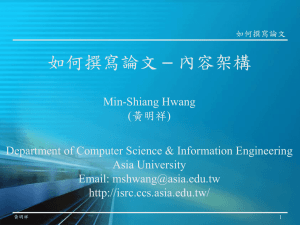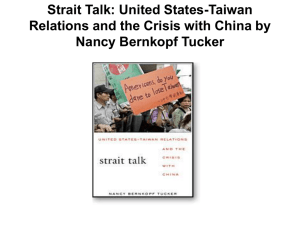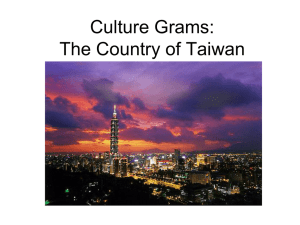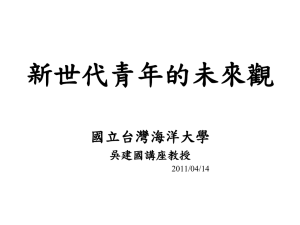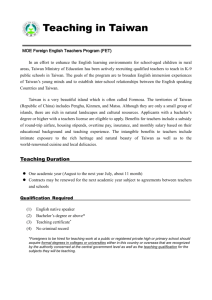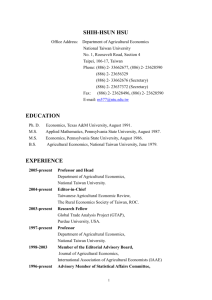Seminar on Cross –Taiwan Strait Relations
advertisement
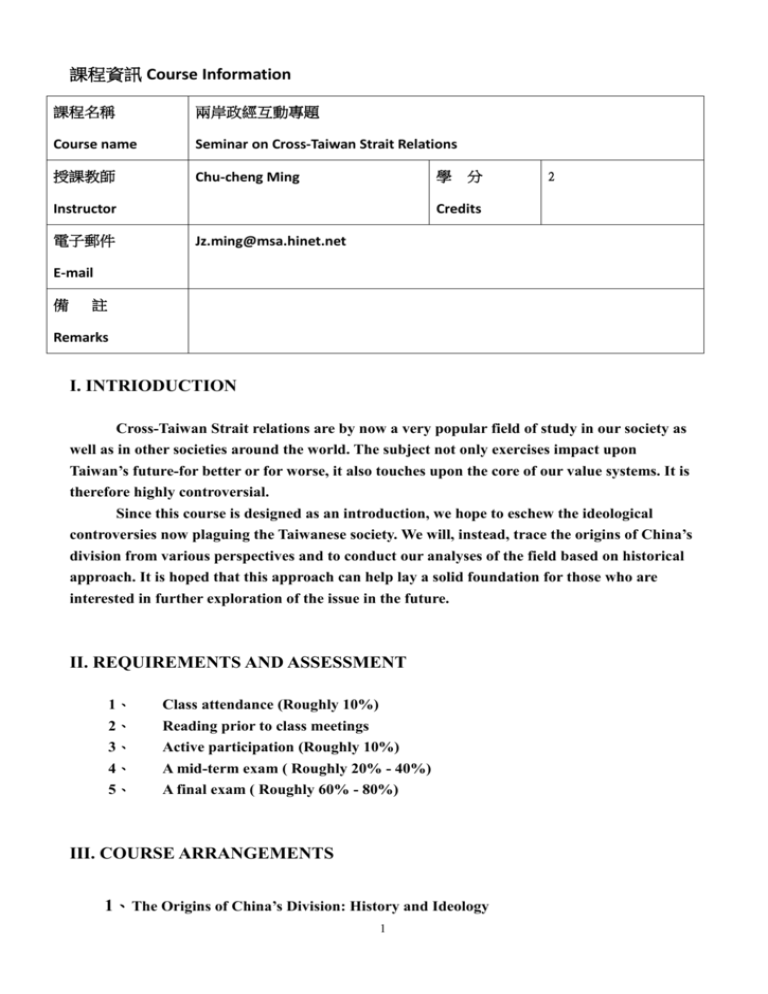
課程資訊 Course Information 課程名稱 兩岸政經互動專題 Course name Seminar on Cross-Taiwan Strait Relations 授課教師 Chu-cheng Ming 學 Instructor 電子郵件 分 2 Credits Jz.ming@msa.hinet.net E-mail 備 註 Remarks I. INTRIODUCTION Cross-Taiwan Strait relations are by now a very popular field of study in our society as well as in other societies around the world. The subject not only exercises impact upon Taiwan’s future-for better or for worse, it also touches upon the core of our value systems. It is therefore highly controversial. Since this course is designed as an introduction, we hope to eschew the ideological controversies now plaguing the Taiwanese society. We will, instead, trace the origins of China’s division from various perspectives and to conduct our analyses of the field based on historical approach. It is hoped that this approach can help lay a solid foundation for those who are interested in further exploration of the issue in the future. II. REQUIREMENTS AND ASSESSMENT 1、 2、 Class attendance (Roughly 10%) Reading prior to class meetings 3、 4、 5、 Active participation (Roughly 10%) A mid-term exam ( Roughly 20% - 40%) A final exam ( Roughly 60% - 80%) III. COURSE ARRANGEMENTS 1、The Origins of China’s Division: History and Ideology 1 (1) Immanuel C. Y. Hsu, The Rise of Modern China, Chapters 20 - 25 (2) Mainland Affairs Council, 1994, Relations Across the Taiwan Strait 2、 The KMT-CCP Relations and China’s Division ( 1 ) Immanuel C. Y. Hsu, The Rise of Modern China, Chapters 20 - 25 3、 Military Confrontation:1949─1954 ( 1 ) Immanuel C. Y. Hsu, The Rise of Modern China, Chapters 26 - 27 4、 Cold War Stalemate:1955─1990 (1) Immanuel C. Y. Hsu, The Rise of Modern China, Chapters 26 - 29 (2) Immanuel C. Y. Hsu, The Rise of Modern China, Chapters 31 (3) Ralph Clough, 1992, Taiwan under the KMT’s Rule, in Cambridge History of China : The People’s Republic, eds. by R. MacFarquar and J. K. Fairbank 5、 Cross-Strait Exchanges ( I ):1991─Present (1) Kenneth S. Lin, “Cross-Strait Economic Integration and Its Impacts on Taiwan’s Society,” in I Yuan, ed., Is There a Greater China Identity? (Taipei: Institute of International Relations, 2007), pp. 273-300. (2) Steve Chan, “The Politics of Economic Exchange: Carrots and Sticks in Taiwan-China-U.S. Relations,” Issues & Studies, Volume 42, Number 2 (June 2006): 1-22. (3) Chyungly Lee, “Cross-Strait Economic Ties and Taiwan’s Economic Security: An Analytical Framework from a Nontraditional Security Perspective,” Issues & Studies, Volume 43, Number 1 (March 2007): 189-216. 6. Mid-term Exam 7. Cross-Strait Exchanges ( II ):1991─Present 2 (1) Alan Wachman, Why Taiwan? Geostrategic Rationales for China’s Territorial Integrity (Stanford: Stanford University Press, 2007), chapter 1 (2) Elizabeth Freund Larus, “Taiwan’s Quest for International Recognition,” Issues & Studies, Volume 42, Number 2 (June 2006): 23-52. 8. Evolution of the PRC’s Taiwan Policy (1) Suisheng Zhao, “Chinese Nationalism and Beijing’s Policy toward Taiwan,” in I Yuan, ed., Is There a Greater China Identity? (Taipei: Institute of International Relations, 2007), pp. 173-192. (2) Jiang Zemin, 1995, Eight-point Proposal (3) PRC, 2005, Anti-Secession Law (4) Chen-yi Lin, “The Rise of China and Taiwanese Response: The Anti-Secession Law as a Case Study,” Issues & Studies, Volume 43, Number 1 (March 2007): 159-188. 9. Evolution of the ROC’s Mainland Policy (1) Michael Hsiao and Jiann-Fa Yan, “Taiwan’s New National Identity and Its Impacts on Domestic Party Contention and Cross-Strait Relations,” in I Yuan, ed., Is There a Greater China Identity? (Taipei: Institute of International Relations, 2007), pp. 93-114. (2) Mumin Chen“From Five No’s to Referendum: The Making of National Security Policy in Taiwan,” Issues & Studies, Volume 43, Number 3 (September 2007): 199-237. (3) Edward Friedman, “Taiwan’s Independence Plot,” Issues & Studies, Volume 42, Number 4 (December 2006): 67-95. 10. Impact of International Factors (1)USA and PRC, 1972, The Shanghai Communique 3 (2)USA and PRC, 1979, The Communique (3)USA, 1979, The Taiwan Relation Act (4)USA and PRC, 1982, The Communique, (5)Gang Lin, “U.S. Strategies in Maintaining Peace across the Taiwan Strait,” Issues & Studies, Volume 43, Number 2 (June 2007): 217-235. 11. Review and Concluding Remarks (1) Lowell Dittmer“On the Prospect of an Interim Solution to the China-Taiwan Crisis,” China Information, Volume 14, Number 1 (2001): 58-68. (2) Kenneth Lieberthal, “Preventing War Over Taiwan,” Foreign Affairs, Volume 84, Number 2 (March/April 2004): 53-63. (3) Michael D. Swaine, “Trouble in Taiwan,” Foreign Affairs, Volume 83, Number 2 (March/April 2004): 39-49. (4) Yu-Shan Wu, “Domestic Political Competition and Triangular Interaction Among Washington, Beijing, and Taipei: The U.S. China Policy,” Issues & Studies, Volume 42, Number 1 (March 2006): 1-46. 4



